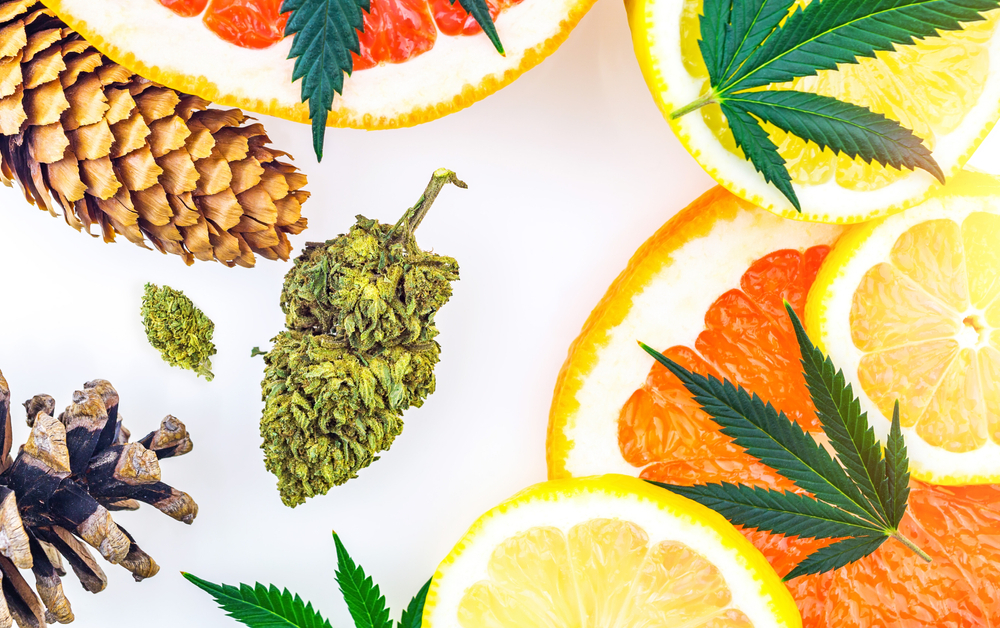At our medical dispensary, we’re not just about providing premium medicinal cannabis but also about immersing our community in the holistic knowledge of our favorite plant. Today, we’re diving into something intriguing: terpene side effects.
These aromatic compounds are why that fresh jar of your chosen strain greets you with a familiar, irresistible scent. Yes, that delightful smell that makes you feel like you’re reuniting with an old friend – that’s terpenes at work. However, their role extends beyond just enticing your senses.

Terpenes not only give each cannabis strain its unique fragrance but also safeguard the plant, offering a spectrum of potential health and wellness advantages. So, the next time you savor the aroma from your cannabis, remember it’s the terpenes weaving their magic, a perfect blend of nature’s protection and pleasure.
Recently, more and more cannabis users are waking up to the fact that terpenes matter just as much as cannabinoid content. Like cannabinoids, terpenes are naturally occurring aromatic compounds present in the trichomes of female cannabis plants. Similarly, cannabis cultivars with different terpene profiles may also have different medicinal properties and influence the psychoactive effects of cannabis in different ways.
The cannabis plant has more than 400 terpenes, but most of these essential oils are only present in trace amounts. That said, there’s a handful of prominent terps in many popular cannabis strains that give them their unique nose. And as you know, nothing smells quite like Blue Dream or Sour Diesel!
This is even more prominent with cannabis extract, which contains these natural compounds in higher concentrations. Cannabis extracts and concentrates are all about the terps!
But, when you’re choosing flower, we like to say the nose knows. If a strain smells good to you, you’ll probably like it. But terpenes also play a vital role in protecting the cannabis plant.
Because terpenes are essential oils produced in the plant’s trichomes, these volatile compounds are present in higher concentrations in the female cannabis plant than in the male plant.
Terpenes influence the cannabis plant’s color and pigmentation. They may also deter harmful insects and animals while attracting beneficial ones. Geraniol and Linalool are great examples. Gerinol repels predatory insects, while Linalool attracts insects that pollinate cannabis, ensuring the survival of the species.
The cannabis plant’s immune system also gets a boost from terpenes, which trigger immune responses to environmental stress. Interestingly, terpenes may perform a similar function in humans by affecting the human endocannabinoid system (more to come.)
One reason we know as much as we do about cannabis terpenes is that these essential oils are not unique to cannabis strains. In Ayurvedic medicine, these chemical compounds have been used for their therapeutic properties for centuries. If you’ve ever used lavender oil to relieve anxiety, you’ve used terpenes medicinally.
Despite Ayurveda’s long tradition, in the West, these compounds are still considered a new frontier in cannabis medicine because we do not have enough scientific studies. That said, some preclinical studies identify a range of therapeutic benefits associated with terpenes:
Of the four studies cited here, the 2021 study is the most compelling because it looked at the effects of terpenes and cannabinoids together as they do naturally in the cannabis plant or in whole-plant preparations. When used together in this way, these organic compounds showed improved pain relief and anti-inflammatory properties.
This same study also established that certain terpenes affect the body’s CB2 receptors, part of the human endocannabinoid system. This finding is critical because it supports the idea that terpenes are chemical compounds that influence the effects of cannabinoids in humans, thus supporting the “entourage effect” theory (we’ll get to that theory soon!)
While there are over 400 terpenes found in cannabis, some are far more prevalent than others. Some of those terpenes include:
Linalool is found in lavender, mint, cinnamon, coriander, and cannabis. Spicy and floral, this cannabis terpene shares the relaxing properties of these aromatic herbs and offers a range of health benefits.
Linalool has anti-inflammatory, analgesic, and anxiolytic properties. It is known to provide relief for conditions such as arthritis, depression, seizures, insomnia, and cancer.
Humulene is found in hops, ginseng, sage, cloves, black pepper and cannabis. This terpene has spicy, earthy notes and like most terpenes, carries potential medical and therapeutic properties.
Early research has shown humulene to be anti-proliferative, meaning it may prevent cancer cells from growing. It may also be an effective appetite suppressant, inflammation reducer, pain reliever, and fight bacterial infections.
If you’ve ever caught a whiff of a fruit rind, you’ve encountered limonene. Although widely used in cleaning products and makeup, don’t assume that every citrus-scented cannabis strain contains limonene — always verify through lab tests.
While limonene is a notable terpene in cannabis, it appears in trace amounts, typically less than 2%. In contrast, THC can make up to 30% of a flower’s dry weight.
Despite limonene’s potential therapeutic benefits, existing studies often use limonene concentrations much higher than those naturally present in a cannabis strain. More research is imperative to deepen our understanding.
Caryophyllene is one of the cannabis plant’s most prevalent terpenes, with a spicy fragrance reminiscent of cracked pepper. What’s most compelling is that caryophyllene acts like a cannabinoid by activating cannabinoid receptors like a cannabinoid.
When humans ingest THC, it binds to the endocannabinoid system’s CB1 receptor, eliciting a euphoric effect. In contrast, caryophyllene attaches to the CB2 receptor, making it non-intoxicating while still delivering health benefits such as reducing inflammation.
Myrcene is a prevalent terpene in cannabis strains. It has a spicy and musky nose and tastes somewhat sweet. You will also find myrcene in hops, eucalyptus, lemongrass, and mangoes.
Cannabis with myrcene levels above 0.5% may help with relaxation. Cannabis cultivars below this 0.5% threshold may be more energizing.
While It may seem like we know a lot about terpenes, we’ve barely scratched the surface. Again, more research is needed.
Humans have an endocannabinoid system (“ECS”) that maintains homeostasis in body processes such as mood, sleep, pain, appetite, and memory. Think of it like a signaling network made up of cannabinoid receptors and endocannabinoids (cannabinoids produced by the body) located throughout the body.
There are two types of cannabinoid receptors: CB1 and CB2. Endocannabinoids stimulate these receptors. Cannabinoids in cannabis mimic endocannabinoids and bind with those receptors to cause the medicinal effects that we associate with cannabis, such as pain relief or relaxation.
But cannabinoids aren’t the only thing that can stimulate this system and offer potential health benefits. It turns out that the cannabis plant compounds terpenes can as well. Remember, “…caryophyllene attaches to the CB2 receptor, making it non-intoxicating while still delivering health benefits such as reducing inflammation.” So, terpenes have an effect here, and it’s yet another reason why more research is needed.
Another interesting fact about the endocannabinoid system is that they are like fingerprints. They are unique to the person. This is why the same cannabis strain can affect people differently.
In 1999, the chemists Raphael Mechoulam and Shimon Ben-ShabaIn theorized that cannabinoids and terpenes in cannabis work synergistically. They called this theory the entourage effect, and it was because it contradicted the mainstream belief that THC was what caused the effects of cannabis.
Today, the idea that THC alone causes the effects of cannabis is antiquated. A 2011 Review of Studies in The British Journal of Pharmacology found that taking cannabinoids and terpenes together may provide additional therapeutic benefits for the treatment of:
Therefore, terpenes likely have therapeutic effects that work synergistically with cannabinoids.
Cannabis terpenes are on the cutting edge of cannabis science and human wellness. If you’d like to learn more about their potential health benefits, let Noa Botanicals guide you to the cannabis cultivar with the perfect terpene profile for your needs.
Drop by anytime, and our friendly knowledgeable staff will answer all your terpene questions. Or you can visit us online at Noa Botanicals and order ahead for pickup!
They do. Caryophyllene may reduce inflammation. Humelene may fight bacterial infections.
No. Most terpenes act differently in the body. One exception is caryophyllene. There may be more, but again, more research is needed.
Research is always a good idea. There are many amazing online resources. You could also ask your Budtender for the Certificate of Analysis (“COA”) that breaks down the terpene and cannabinoid profile of cannabis strains.
The early research indicates that cannabis terpenes have medicinal uses. Beyond that, there are years of anecdotal evidence from medical patients using different cannabis strains with different terpene profiles that support the research.
As we know, more research is needed. But the terpenes that have been researched all appear to be medicinal powerhouses.
Supercritical Co2 extraction, extractions that use solvents such as propane or hexane, and solventless extractions methods that use ice water and agitation are all methods used to isolate or produce terpene-rich extracts and concentrates.
When taken in high doses in their pure form, terpenes may have side effects, such as dizziness or headaches. In their natural form in the cannabis plant, it’s hard to attribute negative effects to terpenes since they are working in synergy with cannabinoids. That said, to the extent that some people experience anxiety when they smoke Sativa, it’s possible that cannabis sativa terpenes play a role in causing that anxiety.
About Noa Botanicals | Privacy Policy | Terms of Use | ©2025 Mānoa Botanicals LLC dba Noa Botanicals. All Rights Reserved.

You must be over 18 to preview our website.